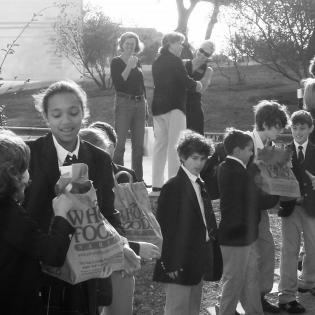Sacred Giving: When? (Private-Religious)
Performance of the mitzvah of tzedakah is, ideally, a holistic part of life, not an activity to be performed when all others have been completed! This lesson offers a classic model of how that ideal was realized by one of our Sages, Rabbi Tanchum, and how our families might adapt the model to their own lives.
The learner will:
- retell the story of Rabbi Tanchum and his tzedakah-model.
- cite ways that their family can adapt a tzedakah-model to their own lives, incorporating tzedakah into family celebrations and observances.
- practice an additional or new act of tzedakah.
- identify and describe the outcomes of this additional or new act of tzedakah.
- Attachment One: Sacred Giving: When?
- Attachment Two: Creating a Family “Tzedakah-Habit”
Families will create a family tzedakah project, explained in Attachment Two: Creating a Family "Tzedakah Habit"
Instructions
Anticipatory SetMake two columns on the blackboard, one headed “GOOD HABIT”, the other, “BAD HABIT”. Ask the learners to assist you in creating lists of both. Once completed, ask them if they have ever tried to break or start a habit. What techniques did they use to accomplish their goal? Were they successful? Which techniques were most helpful?
Teacher Note: Lead the learners to an understanding that the least successful techniques often require major life changes, and that the most successful techniques usually are those that enable one to assimilate change within ones normal life pattern. For example, some people find going to a gym very difficult. It might require coming home from work, changing clothes, getting back into the snow-covered car and going to find a parking spot in a crowded lot at the mall. Asking the learners to exercising while watching TV at home might be easier for the learners to accomplish. Diets that require purchasing special foods are hard to keep; diets that teach you how to prepare real food in low-calorie ways are easier to fit into the life of the family.
Distribute Attachment One: Sacred Giving: When?
Teacher Note: The Torah texts are about doing tzedakah as a part of “real life”; adding Jewish values to the value of work. This activity is intended to have students think of the times that they value and apply the Jewish value of tzedakah to those times.
Distribute Attachment Two: Creating a Family “Tzedakah-Habit”
Use Attachment One: Sacred Giving: When? as an assessment to evaluate the students understanding of the two Biblical verses.
The learners and their families are asked to create a Family “Tzedakah-Habit”
Philanthropy Framework
-
Strand PHIL.III Philanthropy and the Individual
-
Standard PI 01. Reasons for Individual Philanthropy
-
Benchmark MS.5 Describe the responsibility students have to act in the civil society sector to improve the common good.
-
-
-
Strand PHIL.IV Volunteering and Service
-
Standard VS 01. Needs Assessment
-
Benchmark MS.1 Identify a need in the school, local community, state, nation, or world.
-
-
Standard VS 03. Providing Service
-
Benchmark MS.1 Provide a needed service.
-
-
Standard VS 05. Integrating the Service Experience into Learning
-
Benchmark MS.3 Identify outcomes from the service.
-
-
